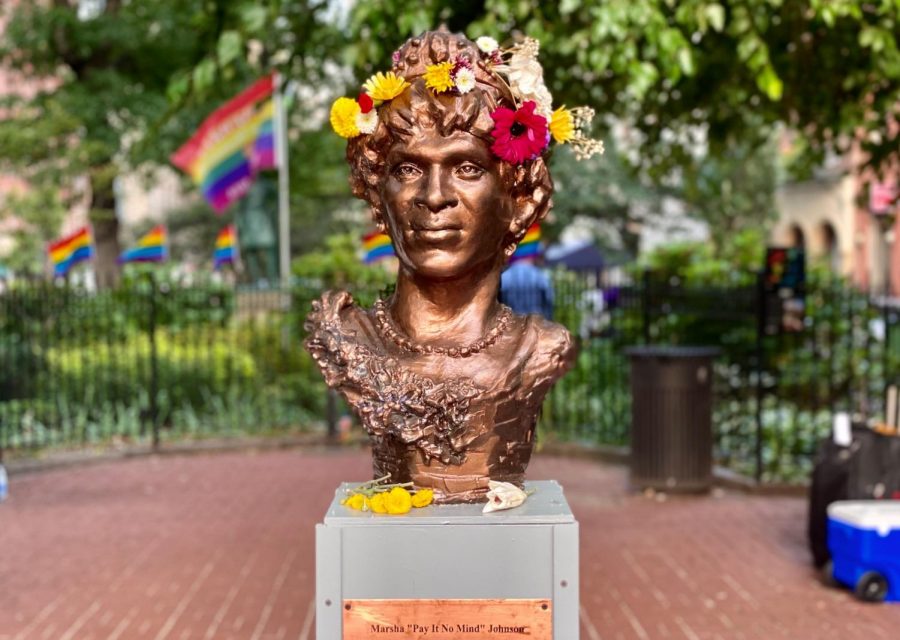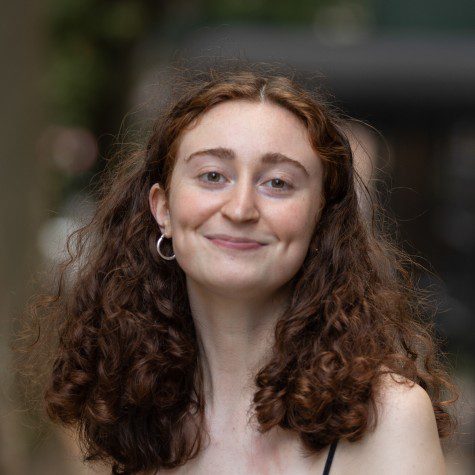Guerrilla memorial is NYC’s first statue of a trans person
The unauthorized statue of gay liberation activist Marsha P. Johnson in Christopher Park amplifies the silenced Black transgender voices of the LGBTQ+ movement.
The statue of Marsha P. Johnson, decorated in a wreath and flowers, stands in Christopher Park. This monument honoring the gay liberation pioneer was installed by a local artist without city authorization. (Staff Photo by Sirui Wu)
September 20, 2021
In 2019, New York City announced plans to install a monument honoring gay liberation pioneer and Black transgender activist Marsha P. Johnson down the street from the Stonewall Inn, a historic safe haven for the LGBTQ+ community. After repeated delays due to the pandemic, Jesse Pallotta — an artist, sex worker and transgender activist — was tired of waiting for the statue to materialize.
At a New Year’s Eve party in 2020, Pallotta and their friends decided to take matters into their own hands. Pallotta, a trained sculptor, began by hanging 100 photographs of Johnson on their wall to sketch.
“It was a three month process of sculpting, and I had this moment when I finally got her eyes after days of trying to figure out her gaze and just started crying,” Pallotta said. “I felt like I could really see Marsha for the first time. This person who I thought about for years and years when I was really struggling was super present.”
The completed statue of Johnson has stood in Christopher Park across from the Stonewall Inn since Aug. 24 without the city’s approval. It is the first monument of a transgender person in a New York City park and the first to depict a Stonewall riots participant. Since then, Pallotta has submitted a First Amendment permit through the National Park Service to protect the statue. They plan to temporarily install the statue at the LGBTQ Community Center in Manhattan in the coming weeks.
“We never attempted to go through the city,” Pallotta said. “I was hoping that Marsha’s beauty is so impactful on its own that people would not mind that it was there — and it actually seems to be working. I anticipated that it would be taken down within two to three days, so I was prepared for that.”
Johnson — a key figure in the 1969 Stonewall riots, co-creator of the Street Transvestite Action Revolutionaries and member of the AIDS Coalition to Unleash Power — spearheaded a five-day sit-in at NYU’s Weinstein Residence Hall in September 1970 after the university refused to provide the LGBTQ+ community access to on-campus facilities for meetings and dances.
“The issues that were being raised in those protests remain absolutely central at NYU,” Emmaia Gelman, an NYU lecturer teaching a course called Queer NYC, said. “The fact that the Weinstein occupation of protests lives on as part of queer NYU memory is a testament to the fact that the work they did in leading these rowdy, unruly and unbounded protests continues to be incredibly important.”
According to Pallotta, the statue of Johnson, located directly adjacent to the “Gay Liberation” sculpture created by NYU alum George Segal, comments on the existing rhetoric of the Queer Liberation Monument, which continues to exclude the voices of transgender people — and, in particular, trans people of color.
Marc Robert Stein, a professor of history at San Francisco State University and editor of “The Stonewall Riots,” said the sculpture symbolizes the diversity and intersectionality of the LGBTQ+ community, since Johnson was Black, gay, transgender, poor and a sex worker.
“Her embodiment of those identities served and serves as a reminder of divisions and hierarchies within queer and trans worlds,” Stein said. “Although I haven’t seen the statue yet [in person], its placement in proximity to George Segal’s ‘Gay Liberation’ work — often described as featuring two standing white men and two seated white women — might also serve to create conversation and dialogue about the gender, class, race and sexual politics of artistic representation.”
Gelman added that it is important that Johnson is being honored by the public today, since she did not receive recognition during her lifetime.
“At the time, people were really focused on activism and concerned about respectability and coherence,” Gelman said. “Not everyone, but many organizers and also the spaces in which people organized didn’t necessarily understand people who were breaking the mold as leaders. It’s painful to have watched folks like Marsha and Sylvia experience so much rejection in their lives and now be celebrated.”
Chris Woods, the director of NYU’s LGBTQ+ Center, declined to make a statement to WSN, but said he visited the monument and that he was excited that Johnson is receiving recognition.
TS Candii — a Black transgender woman, sex worker, executive director of Black Trans Nation and member of the organizing group behind the sculpture — has continued to fight for Black transgender representation, particularly through the Repeal Walking While Trans Ban coalition. Before its repeal in February, the “walking while trans” law allowed police to detain anyone loitering who they believed was engaging in sex work. LGBTQ+ activists, including Candii, argued that the law disproportionately targeted transgender women, especially transgender women of color.
When Candii first saw the statue of Johnson, who was also a sex worker, she said she immediately felt that Johnson’s spirit would unite the LGBTQ+ community.
“I looked at Marsha in her eyes and it was a call to me,” Candii said. “I’m glad that it was created and placed there so it can bring the bigger discussion of the visibility of Black transgender women. Marsha risked her life to set the LGBTQ+ community free. She was the definition of fearless, and put up a fight for her belief in her right.”
After seeing the sculpture, Katherine Carlson — a language lecturer in NYU’s expository writing program and Pallotta’s neighbor — plans to have her students write about the ways in which the statue comments on Johnson and her presence in the park.
“The first thing I thought about was how natural it looks there,” Carlson said. “I can see how easily any city authority could forget that it had always been there. Greenwich Village is a stronghold of queer history, and NYU students have an adjacency to this that is within steps.”
Pallotta said that during the design process, the group aimed to represent Johnson with a stoic presence to embody the strength and beauty that were central to her character.
“Anyone who did that much work and followed through with all the projects that she did shows a deeper level of commitment, and her expression is rooted in that,” Pallotta said. “I have her head tilted slightly to the right, and I was thinking about the idea of her always looking at the people around her, so her eye gaze is slightly upwards.”
For Pallotta, Johnson continues to serve as an inspiration to take care of their community and the people surrounding them.
“When I’m struggling, I find a lot of healing through reflecting on Marsha’s legacy and her story,” Pallotta said. “If she did all of this amazing work, then I can overcome any kind of stereotypes and stigmas about my identity and my profession.”
A version of this piece appeared in the Monday, Sept. 20, 2021, e-print edition. Contact Rachel Cohen at [email protected].

























































































































































